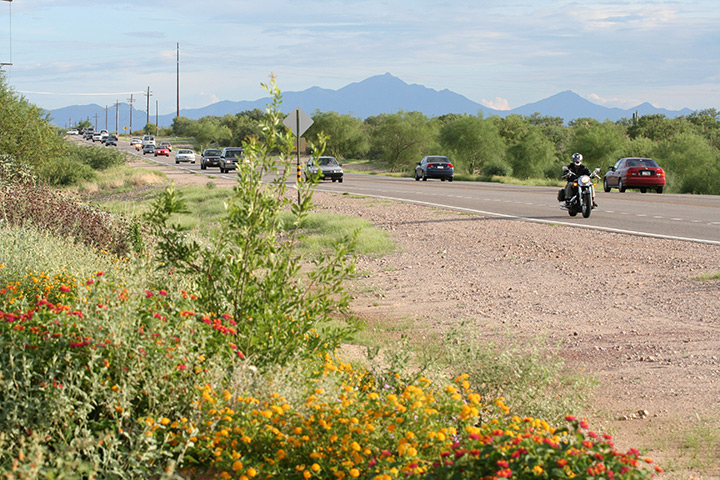
The Regional Transportation Authority is celebrating 15 years of delivering on the promises it made to voters who approved the RTA’s 20-year regional transportation plan in 2006.
In addition to delivering specific roadway corridor projects voters saw on the ballot, the RTA has completed hundreds of bicycle and pedestrian safety improvements, expanded transit services and improved traffic signal technology. Other projects include new bus pullouts and intersection improvements and projects that ensure environmental and economic vitality.
The track record of the RTA shows the region can come together to do things differently – for everyone’s benefit.
How the RTA came to be
In the early 2000s, a pattern of rapid population growth throughout Pima County led to a need for timely improvements to the region’s transportation infrastructure. Without these improvements, the region expected to face a significant increase in traffic congestion and almost certain gridlock.
In 2002 and 2003, respectively, two City of Tucson transportation voter initiatives failed. Two countywide initiatives had also failed in the previous decades.
Failure was no longer an option.
Regional leadership recognized an opportunity to authorize a Regional Transportation Authority to develop a multimodal transportation plan and seek a regional tax to fund it. As discussions of developing the RTA were advancing, former Pima County Supervisor Ramón Valadez and former Tucson Mayor Bob Walkup, who were serving on the Pima Association of Governments’ Regional Council, decided they would give up their veto, or weighted voting based on population, to ensure the new RTA Board would work together as true partners for the benefit of the region.
“We did this because we understood that if we were to be successful, this had to be a collaborative effort of all partners in our region,” said Mr. Valadez, a former RTA Board Chair. In an August 2020 letter he wrote to the current RTA Citizens Advisory Committee and the RTA Technical Management Committee and reminded them what it took to prevail with voters.
“It was a clear signal to our entire community that the RTA was not going to be business as usual but rather a new way of doing business that was citizen driven (not jurisdiction driven), accountable and transparent and, most of all, together as one region and absent of jurisdictional boundaries or turf wars.”
In 2004, then-state Rep. Steve Huffman (R-Tucson) introduced an RTA reauthorization bill, which the House and Senate approved, and then-Gov. Janet Napolitano signed into law. The new RTA statutes authorized the formation of the Regional Transportation Authority and gave each member of the RTA Board one vote. The legislation allowed the RTA to seek voter approval of a 20-year countywide transportation tax and develop a 20-year regional transportation plan, also requiring voter approval.
What’s working
In the past 15 years, visible transportation improvements have proliferated. They range from road improvements such as the Grant Road widening from Oracle Road to Park Avenue; transit improvements such as the Sun Link streetcar system, and expanded transit hours that provide service to more areas.
Other, less-visible boosts to the region include wildlife crossings throughout the metro area, a business assistance program to support businesses throughout construction projects, and drainage improvements to prevent costly flooding for homes and commercial spaces.
With the RTA funding for these projects, local jurisdictions such as cities, towns and the county have been able to use other transportation funding sources to implement pavement preservation and other local priorities.
Developing the next phase
The Regional Transportation Authority created a Citizens Advisory Committee to contemplate and propose a second RTA plan, known now as the RTA Next process.
The committee has been reviewing proposals from local governments, native nations and community groups regarding respective regional transportation needs spanning a plan period of 2026 to 2046.
In his August 2020 message, Mr. Valadez said that the current process established for developing the next RTA plan, including a diverse CAC, will lead to a new plan the public will support.
He also reminded the committee chairs that the voters are the ultimate decision makers and “we need to ensure the final plan is acceptable to them. As we have learned through many prior transportation initiatives over the years, individual jurisdiction project wishes without an extensive citizen-driven process and regional focus do not fare well on the ballot.”
Remembering an instrumental figure
In memory of Bob Walkup, mayor of the City of Tucson from 1999 to 2011, Pima Association of Governments and the Regional Transportation Authority share the following images to honor the impact he had while serving on the PAG Regional Council and RTA Board. He was instrumental in ensuring the bodies maintained a regional focus by agreeing with the county representative, former Supervisor Ramon Valadez, to give up weighted voting and allow one vote per member during the formation of the RTA.

